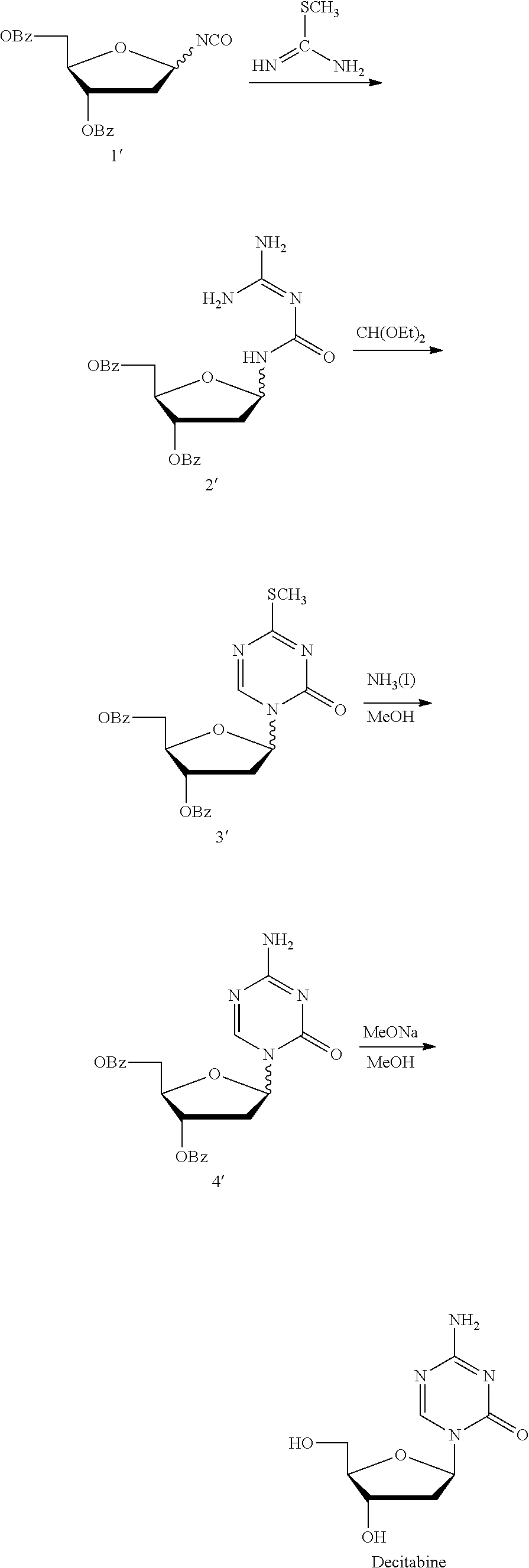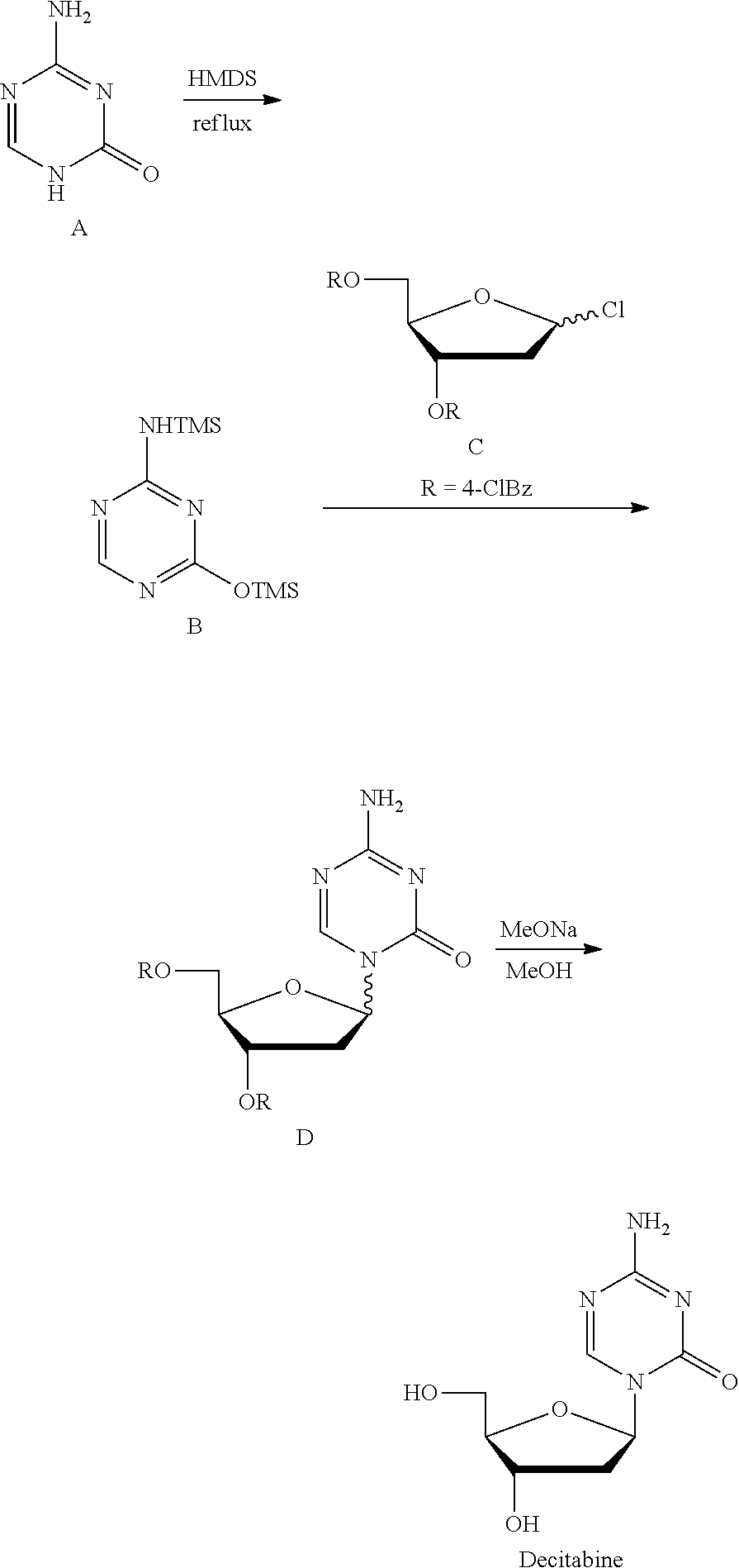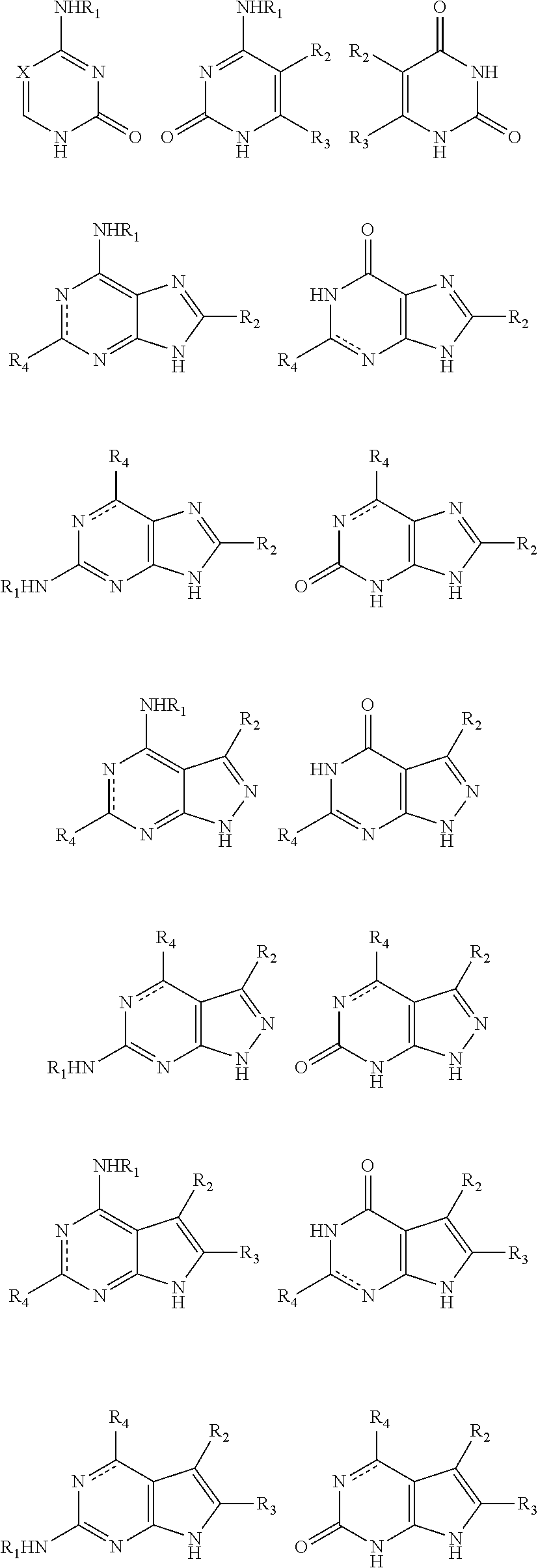A method for preparing a ß-nucleoside compound
- Summary
- Abstract
- Description
- Claims
- Application Information
AI Technical Summary
Benefits of technology
Problems solved by technology
Method used
Image
Examples
embodiment 1 preparation
of Decitabine
1-(3,5-di-O-p-cholrobenzoyl-2-deoxy-β-D-ribofuranose)-5-azacytosine (Intermediate D)
[0093]To the reaction flask were added 5-azacytosine 20.0 g and dichloromethane 87.5 mL, into which was added triethylamine 62.1 mL with stirring at 15° C., and dropped trimethylsilyl trifluoromethanesulfonate 118.9 g, continued stirring for 30 min after the system was dissolved to clear. The reaction liquid, without being isolated, was directly added into 1-chloro-3,5-di-O-p-cholrobenzoyl-deoxy-D-ribofuranose 38.3 g, and stirred for about 3 h at 0° C. until the reaction liquid was clear. Triethylamine 37 mL was added to quench the reaction, into which was added dichloromethane and water 500 mL for each respectively, the organic phase was filtered, isolated and concentrated to dry, to the residue of which was added 500 mL water and stirred adequately, suction filtered, and the solid was dried for 6 h at 45° C. in vacuum, crushed, and continued drying for 3 h to give the intermediate D 42...
embodiment 2 preparation
of Decitabine
1-(3,5-di-O-cholrobenzoyl-2-deoxy-β-D-ribofuranose-5-azacytosine (Intermediate D)
[0098]To the reaction flask were added 5-azacytosine 88.5 g and dichloromethane 395 mL, into which was added triethylamine 274.4 mL with stirring at −10° C. Trimethylsilyl trifluoromethanesulfonate 526.3 g was dropped in and continued stirring for 30 min after the system was dissolved to clear. The reaction liquid, without being isolated, was directly added into 1-chloro-3,5-di-O-p-cholrobenzoyl-deoxy-D-ribofuranose 169.6 g, and stirred for about 6 h at −10° C. until the reaction liquid was clear. Triethylamine 164.6 mL was added to quench the reaction, into which was added dichloromethane and water 1500 mL for each respectively, the organic phase was filtered, and concentrated to dry, to the residue of which was added 1500 mL water and stirred adequately, suction filtered, and the solid was dried for 6 h at 45° C. in vacuum, crushed, and continued drying for 3 h to give the intermediate D ...
embodiment 3 preparation
of Decitabine
1-(3,5-di-O-p-cholrobenzoyl-2-deoxy-β-D-ribofuranose)-5-azacytosine (Intermediate D)
[0103]To the reaction flask were added 5-azacytosine 30.0 g and dichloromethane 87.5 mL, into which was added triethylamine 86.7 mL with stirring at 0° C. Trimethylsilyl trifluoromethanesulfonate 158.4 g was dropped in and continued stirring for 30 min after the system was dissolved to clear. The reaction liquid, without being isolated, was directly added into 1-chloro-3,5-di-O-p-cholrobenzoyl-deoxy-D-ribofuranose 38.3 g, and stirred for about 1.5 h at 5° C. until the reaction liquid was clear. Triethylamine 37 mL was added to quench the reaction, into which was added dichloromethane and water 500 mL for each respectively, the organic phase was filtered, and concentrated to dry, to the residue of which was added 500 mL water and stirred adequately, suction filtered, and the solid was dried for 6 h at 45° C. in vacuum, crushed, and continued drying for 3 h to give the intermediate D 43.5 ...
PUM
| Property | Measurement | Unit |
|---|---|---|
| Temperature | aaaaa | aaaaa |
| Temperature | aaaaa | aaaaa |
| Cell angle | aaaaa | aaaaa |
Abstract
Description
Claims
Application Information
 Login to View More
Login to View More - R&D
- Intellectual Property
- Life Sciences
- Materials
- Tech Scout
- Unparalleled Data Quality
- Higher Quality Content
- 60% Fewer Hallucinations
Browse by: Latest US Patents, China's latest patents, Technical Efficacy Thesaurus, Application Domain, Technology Topic, Popular Technical Reports.
© 2025 PatSnap. All rights reserved.Legal|Privacy policy|Modern Slavery Act Transparency Statement|Sitemap|About US| Contact US: help@patsnap.com



